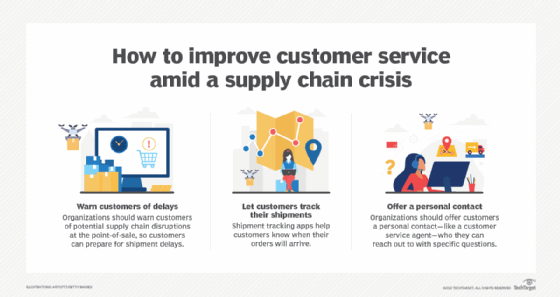
Getty Images
The role of customer service in the supply chain
Amid a supply chain crisis, delays can cause customer satisfaction to plummet. Organizations must use transparency, personalization and empathy to enhance customer service efforts.
CX leaders may think of the supply chain as an input into customer service, but they should understand exactly how these two portions of business intersect.
When the COVID-19 pandemic began, consumers started to see cracks and vulnerabilities in the global supply chain. Before the pandemic, many organizations successfully managed their own supply chains to meet customer demands and business goals. Yet, amid the pandemic, business leaders are at the mercy of factors they can't control. To thrive amid supply chain disruptions, organizations should increase levels of transparency, personalization and empathy in their customer service.
3 steps to handle customer service in a supply chain crisis
When supply chain hurdles arise, organizations can create customer-centric communication systems that inform customers of shipment delays and other updates. Transparency and communication can help organizations satisfy customers despite long lead times and unexpected delays.
Customer service managers should use the following tips to keep customers happy amid supply chain complexities.
1. Notify customers of bottlenecks early on
Whether customers make a purchase over the phone, in person or online, organizations should notify them of any potential supply chain bottlenecks before they make that purchase. For example, a furniture company may use a pop-up message on their website to inform customers of a 20-week shipping delay due to supply chain disruptions. Although not ideal, the message lets customers know what to expect and helps them understand why they may experience delays.
2. Offer a shipment tracking app
To let customers know when their orders will arrive, organizations should offer shipment tracking apps. These tools can offer delivery timelines and status updates as customers' packages move along the shipment process. Additionally, some tools offer GPS tracking for last mile delivery, which lets customer track the location of their package's delivery truck in real time.

3. Provide personal contacts
Some customers may have questions or struggle to use a shipment tracking app, so organizations should offer each customer a personal contact from sales or customer service. These contacts can add a personal touch to CX and address the customer's shipment concerns.
Although organizations cannot fix the global supply chain themselves, they can use communication, transparency and personalization to support their customers and keep them updated. These best practices can also reduce phone call and email volume in contact centers, because fewer customers may have questions about their orders' whereabouts.
Tips for customer service teams
Organizations should inform customers about supply chain disruptions early on, but not all experiences end at the website or point of sale. Many customers expect service agents to know where their items are throughout the shipment process.
The following tips can help agents provide quality customer service amid supply chain delays:
- Display empathy to unhappy customers. Agents should try to put themselves in the customers' shoes before they respond to a question.
- Acknowledge how the customer feels.
- Reassure customers that the support team can solve their problems.
- Take ownership of problems and embrace creative solutions. For instance, if only part of an order is ready to ship, ship it in phases.
- Act on customer problems with urgency.
- Make a commitment to the customer. A confident agent that quickly tackles problems can maintain customer satisfaction.
A supply chain crisis causes product shortages and delays, which can lead to customer dissatisfaction. However, organizations can offset this dissatisfaction with transparent and empathetic customer service efforts.







